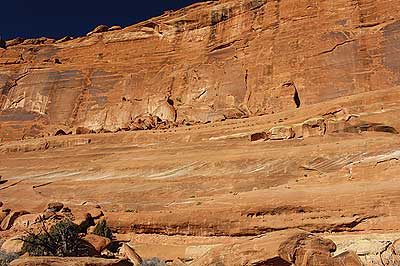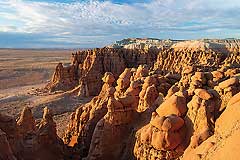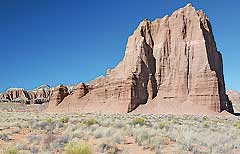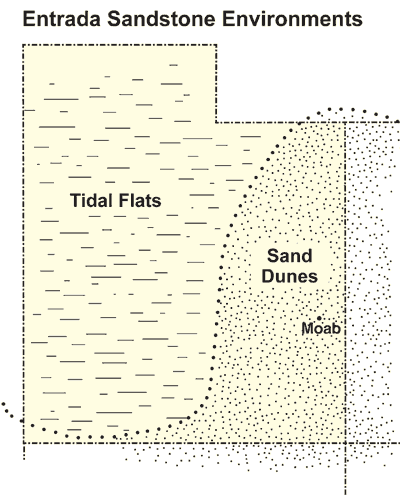| Geology HAPPENINGS January 2019 | ||||||
|
The Entrada Sandstone: Beyond Slickrock |
||||||
Near Moab, the Entrada Sandstone is synonymous with Arches National Park where most of the arches, as well as Balanced Rock, the Fiery Furnace, Devils Garden, and Park Avenue are all sculpted out of the Entrada Sandstone. There, the Entrada forms smooth rounded rock domes and vertical cliffs. Similar pastel reddish-orange domes and cliffs can be found in other especially scenic parts of Moab’s canyon country where the Entrada is also exposed, such as near Monitor and Merrimac Buttes.
Given the characteristic scenery of Arches NP, the Entrada is probably the rock layer (a formation to geologists) that visitors and residents of southeastern Utah are most likely to know. But while many folks know how to recognize the Entrada near Moab, few know that the Entrada is also the rock layer that forms the goblins in Goblin Valley State Park. How can those weirdly-faceted hoodoos, knobs and pinnacles be the same rock layer as the majestic arches and massive slickrock exposures in Arches NP? This question and others related to the Entrada Sandstone can be answered by learning the meaning behind the geological term facies and by exploring the ancient geography of approximately 160 million years ago, when the sediments that later became the Entrada Sandstone were deposited.
Geologists say that a facies change has occurred when one rock type transitions into another rock type in a formation due to a change in depositional environment. The Entrada Sandstone was deposited in two environments: a sand dune field (or erg) that covered southeastern Utah and parts of the adjacent Four Corner states; and an arm of an ancient shallow sea that reached down from the north across what is now central Utah, where silt was deposited in tidal flats. Therefore, going from east to west from Moab to the San Rafael Swell, the Entrada Sandstone undergoes a facies change from sandstone (deposited in dunes) to the siltstone (deposited in tidal flats). Thus, there are two main facies in the Entrada Sandstone in Utah: The eolian (wind- or sand dune-deposited) facies and the “earthy” facies consisting of rocks that were deposited in the tidal basins. The Entrada Sandstone that we all know and love in Arches NP consists of the eolian facies. Near Moab, this facies has been mapped as the Slick Rock Member. (See the December 2018 Geology Happenings column in the Moab Happenings online archive to learn more).
Modern-day Moab sits in the northeastern portion of the large Entrada erg, which extended to central Colorado and into northern New Mexico. Throughout this facies, fine-grain sands were deposited in large sweeping cross-beds, which are distinctive, inclined layers that formed along the faces of the sand dunes as they moved with the winds. This cross-bedding is sometimes seen in the subtle color banding in the rocks of Arches NP. Eolian sandstones are made of small, round sand grains that are nearly uniform in size. Wind is not strong enough to move large sand grains but can carry finer grains (silt and clay) beyond the dune field. As wind-blown sand ricochet (saltate) along the ground, the grains become rounded and frosted by repeated collisions with other grains.
|
||||||
|
||||||



 At Goblin Valley, both the eolian and the earthy facies are intermixed somewhat as this is near the region where the erg met the coastal mud flats. Thin layers of eolian sandstones occur between tidal flat deposits. The relative hardness of these layers of sandstone, siltstone and mudstone, along with the presence of fractures or joints in the rocks, is key to the formation of the goblins or hoodoos that are the state park’s namesake. Hoodoos are fantastic columns of rocks formed by differential erosion of layers that are alternately more or less resistant to erosion.
At Goblin Valley, both the eolian and the earthy facies are intermixed somewhat as this is near the region where the erg met the coastal mud flats. Thin layers of eolian sandstones occur between tidal flat deposits. The relative hardness of these layers of sandstone, siltstone and mudstone, along with the presence of fractures or joints in the rocks, is key to the formation of the goblins or hoodoos that are the state park’s namesake. Hoodoos are fantastic columns of rocks formed by differential erosion of layers that are alternately more or less resistant to erosion. 